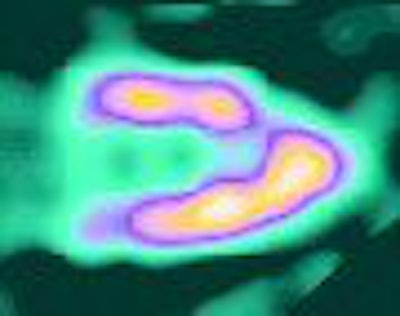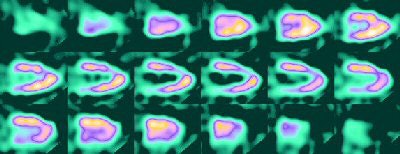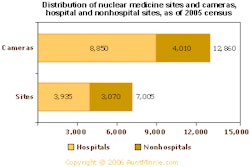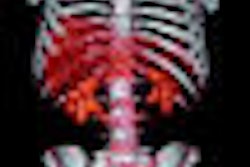
The cardiac gamma camera segment is starting to get crowded. Later this year, nuclear medicine start-up firm CardiArc hopes to hit the market with a dedicated cardiac SPECT camera featuring a novel new design that's a departure from traditional nuclear medicine instrumentation.
CardiArc is the brainchild of Dr. Jack Juni, a nuclear medicine physician who was one of cardiac SPECT's pioneers when he began performing nuclear cardiology studies in 1981. Juni now serves as chairman and chief technical officer of the Lubbock, TX, company.
Juni said he recognized early on that for a noninvasive procedure, nuclear cardiology studies are uncomfortable for patients. He began looking for ways to both make the technology more comfortable and to speed up exam times. At the same time, he believed there was a need for smaller cameras that could be easily sited to take advantage of the growing shift of nuclear cardiology to the outpatient environment.
"Virtually every cardiologist in the U.S. orders SPECT scans on their patients routinely ... it's a standard of care. Yet less than 10% of them have cameras," Juni said. "That is a real disparity. Why don't they have cameras? We came to the conclusion that an awful lot of that was size. They just can't fit (in a physician's office)."
Nine years later Juni's firm is putting the finishing touches on the CardiArc scanner, which includes a number of design updates to traditional gamma camera instrumentation. The biggest change is the positioning of the patient, who rather than lying supine on an imaging couch sits in a chair.
The second major change is system's detector array, which dispenses with the traditional 90° dual-head configuration used in most nuclear cardiology systems. Instead, the CardiArc unit uses a series of curved detectors that form a 180° arc around the patient.
Most nuclear cardiology systems either rotate the camera's detector heads around the patient or rotate the patient while the detector heads remain stationary. CardiArc does neither -- instead, it uses a collimation ring, called an aperture arc, inside the detector array to enable the system to detect photo events. The aperture arc has six narrow vertical slots that collimate incoming photons within each slice.
While most photons will be blocked and absorbed by the aperture arc, the ones that travel through the six slots will strike the detectors located outside the aperture arc. By moving the aperture arc horizontally, and through the use of stationary horizontal lead vanes placed between the aperture arc and the detectors, the system basically creates what CardiArc calls an ultralong-bore collimator for scintillation event detection and localization.
Juni believes that the design results in scans that are both faster and more accurate because the primary moving part -- the aperture arc -- weighs only 15 lb, compared with 1,000 lb for a conventional dual-head camera with collimators. Another advantage of the design, he believes, is that the CardiArc system's detectors are processing photons at all times during the scan. In comparison, a conventional gamma camera with rotating detectors has "dead zones" in its 360° rotation, during which time the system is not receiving photons.
CardiArc is claiming spatial resolution in SPECT scanning mode of 3.65 mm full-width half-maximum (FWHM) at an 82-mm distance. The company believes the system can produce higher contrast and better target-to-background ratios than conventional systems, making subtle abnormalities easier to see. Imaging time is faster as well -- the CardiArc system typically conducts a scan in 2.5 to 3 minutes, compared to 12-20 minutes for a conventional cardiac system, Juni said.
 |
| Vertical long-axis images obtained in 168 seconds (2.8 min) with the CardiArc camera. Target is an anthropomorphic chest phantom (Data Spectrum) with defects placed in the distal anterior and the inferobasal walls. Activity corresponds to a typical Tc-99m stress exam. Images courtesy of CardiArc. |
Finally, CardiArc believes the size of its camera will offer a major advantage for cardiology practices with limited space requirements. The system can be sited in a 6 x 7-ft cubicle, and lead shielding built into the system means that technologists can operate the system from behind the patient without having to leave the room.
CardiArc has developed versions of the camera using both cadmium zinc telluride (CZT) digital detectors and more conventional sodium iodide crystals. Juni believes that production models of CardiArc will use the sodium iodide detectors due to the material's lower cost and ease of manufacturing compared with CZT.
CardiArc received 510(k) clearance from the U.S. Food and Drug Administration in January, and the company hopes to begin selling production units in late 2006 or early 2007. The system will carry a list price of $275,000.
By Brian Casey
AuntMinnie.com staff writer
July 31, 2006
Related Reading
CardiArc shows cardiac SPECT camera, June 7, 2006
CardiArc taps COO, June 5, 2006
CardiArc receives FDA nod for SPECT unit, January 25, 2006
CardiArc seeks clearance for SPECT, November 23, 2005
CardiArc signs investment banker, September 5, 2005
Copyright © 2006 AuntMinnie.com



















